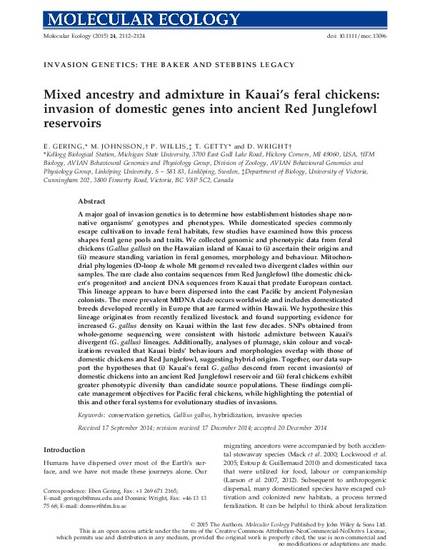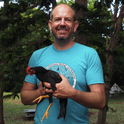
- Conservation genetics,
- Gallius gallus,
- Hybridization,
- Invasive species
- Biology and
- Life Sciences
A major goal of invasion genetics is to determine how establishment histories shape non‐native organisms' genotypes and phenotypes. While domesticated species commonly escape cultivation to invade feral habitats, few studies have examined how this process shapes feral gene pools and traits. We collected genomic and phenotypic data from feral chickens (Gallus gallus) on the Hawaiian island of Kauai to (i) ascertain their origins and (ii) measure standing variation in feral genomes, morphology and behaviour. Mitochondrial phylogenies (D‐loop & whole Mt genome) revealed two divergent clades within our samples. The rare clade also contains sequences from Red Junglefowl (the domestic chicken's progenitor) and ancient DNA sequences from Kauai that predate European contact. This lineage appears to have been dispersed into the east Pacific by ancient Polynesian colonists. The more prevalent MtDNA clade occurs worldwide and includes domesticated breeds developed recently in Europe that are farmed within Hawaii. We hypothesize this lineage originates from recently feralized livestock and found supporting evidence for increased G. gallus density on Kauai within the last few decades. SNPs obtained from whole‐genome sequencing were consistent with historic admixture between Kauai's divergent (G. gallus) lineages. Additionally, analyses of plumage, skin colour and vocalizations revealed that Kauai birds' behaviours and morphologies overlap with those of domestic chickens and Red Junglefowl, suggesting hybrid origins. Together, our data support the hypotheses that (i) Kauai's feral G. gallus descend from recent invasion(s) of domestic chickens into an ancient Red Junglefowl reservoir and (ii) feral chickens exhibit greater phenotypic diversity than candidate source populations. These findings complicate management objectives for Pacific feral chickens, while highlighting the potential of this and other feral systems for evolutionary studies of invasions.
Available at: http://works.bepress.com/eben-gering/13/

©2015 The Authors. Molecular Ecology Published by John Wiley & Sons Ltd.
This is an open access article under the terms of the Creative Commons Attribution‐NonCommercial‐NoDerivs License, which permits use and distribution in any medium, provided the original work is properly cited, the use is non‐commercial and no modifications or adaptations are made.